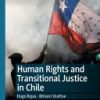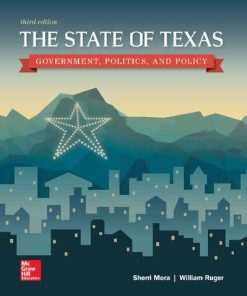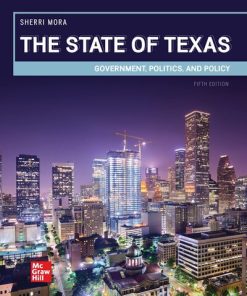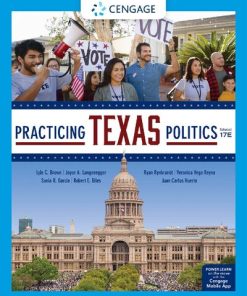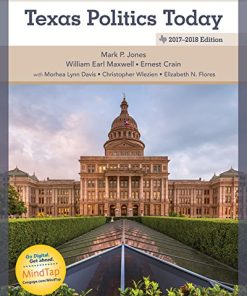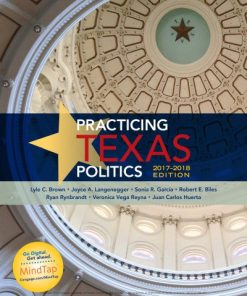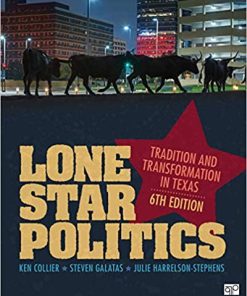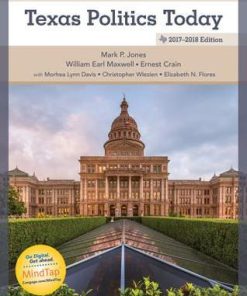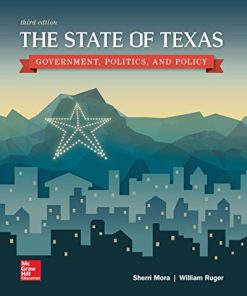Texas Politics Ideal and Reality 13th Edition by Charldean Newell 9798214354354
$50.00 Original price was: $50.00.$25.00Current price is: $25.00.
Texas Politics: Ideal and Reality 13th Edition by Charldean Newell – Ebook PDF Instant Download/DeliveryISBN: 9798214354354
Full download Texas Politics: Ideal and Reality 13th Edition after payment.
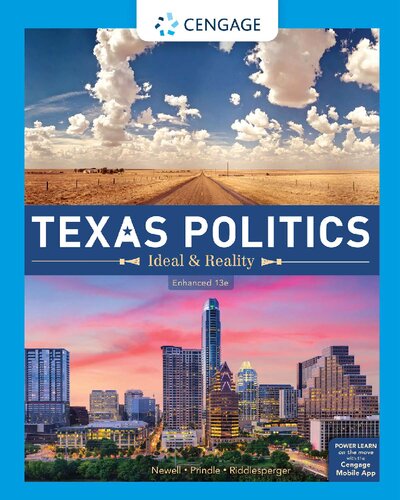
Product details:
ISBN-13 : 9798214354354
Author : Charldean Newell
Newell/Prindle/Riddlesperger’s TEXAS POLITICS: IDEAL AND REALITY, ENHANCED 13th Edition equips you with a thorough understanding of the Texas government and political landscape — and how they impact you personally. The text explores the Texas political system in the context of three main themes: the ideals of democratic theory, political conservatism and private influence over public policy. Its up-to-the-minute coverage includes 2018 election results, immigration, climate change, the fight over mandatory child vaccinations, the ongoing capital punishment debate, the Legislature’s increasing partisan polarization, the link between the actions of the Trump administration and Texas politicians and much more. In addition, MindTap’s “anytime, anywhere” digital learning solutions — eBook, interactive activities, flashcards, quizzes, dictionary and more — help you maximize your study time and course success.
Texas Politics: Ideal and Reality 13th Table of contents:
Chapter 1. The Context of Texas Politics
Texas History: A Chronology
The Earliest Days
Anglo-American Colonization
Revolution
Early Statehood
Post–Civil War Texas
The Late Nineteenth Century
The Early Twentieth Century
Wars and Depression
Post-World-War II Texas
Gradual Political Change
Late Twentieth-Century Texas
Modern Times
Texas as a Democracy
Texas and American Federalism
Texas in the International Arena
The Texas Political Culture
Economy, Taxes, and Services
The People of Texas
The Census
The Political Relevance of Population
Summary
Critical Thinking
Chapter 2. The Constitutional Setting
American Federalism
Division of Power
Federalism at Work
Purposes of Constitutions
Legitimacy
Organizing Government
Providing Power
Limiting Governmental Power
Texas Constitutional Development
The Present Texas Constitution
General Features
Specific Features
Executive Branch
Judicial Branch
Constitutional Change
Overview of the Need for Reform
Constitutional Politics
Summary
Critical Thinking
Chapter 3. Interest Groups
Interest Groups
Definition
Classification
Who Is Organized?
Activities
Information
Electioneering
Lobbying
Who Are the Lobbyists?
What Lobbyists Do and How They Do It
Persuading the Public
Influencing Administrators and Co-Opting Agencies
Interest Groups and the Courts
Regulation of Interest-Group Activity
Major Interest Groups in Texas
Texans for Lawsuit Reform
Doctors
The Christian Right
Organized Labor
League of United Latin American Citizens
Teachers
Summary
Critical Thinking
Chapter 4. Political Parties
Functions of Political Parties
Ideology
Conservatism
Liberalism
Ideology in Texas
Political Socialization
Family
Schools and Churches
Media
Evaluation
Interests
Texas Political Parties: A Brief History
Party Organization
The Temporary Party Organization
Permanent Party Organization
The (Un)Importance of Party Organization
Two Parties, Three Factions (or Perhaps Four)
Republicans
Geographic Distribution
Socioeconomic and Ethnic Distribution
Conservative Democrats
Geographic Distribution
Socioeconomic and Ethnic Distribution
Liberal Democrats
Geographic Distribution
Socioeconomic and Ethnic Distribution
The Future of the Three-Faction System
Third Parties in Texas
Summary
Critical Thinking
Chapter 5. Voting, Campaigns, and Elections
Voting
Why Vote?
Suffrage
Registration
Texas Turnout
Government by the People?
Why Don’t Texans Vote?
The Consequences of Nonvoting
Election Campaigns
Campaign Resources
People
Money
Negative Campaigning
Public Elections
Primary Elections
Texas’s “Open” Primary
When Held
Administration and Finance
General Elections
Special Elections
Absentee or Early Voting
Recent Elections in Texas
Elections of 1994 through 2016
Election of 2018
Summary
Critical Thinking
Chapter 6. The Texas Legislature
Functions of Legislative Bodies
Basic Facts About the Legislature
Size, Elections, and Terms
Sessions
Legislative Districts
Compensation
Membership Characteristics
Formal Qualifications
Personal Characteristics
Power and Influence in the Texas Legislature
Legislative Officers, Committees, and Staff
Presiding Officers
Centralized Power?
Legislative Committees
Legislative Staff
How a Bill Becomes a Law in Texas
Step One: Introduction and Referral
Step Two: Committee Action
Step Three: Floor Action
In The House: Steps One Through Three Repeated
Step Four: Conference Committee
Step Five: The Governor
Legislative Dynamics
Handicaps
Changing Alignments
Nonlegislative Lawmaking
Evaluation and Suggested Reforms
Assessing A Legislative Session
The 86th Legislative Session, 2019
Summary
Critical Thinking
Chapter 7. The Governor
Basic Structure of the Governor’s Office
Election
Term of Office
Tenure
Impeachment and Succession
Compensation
Staff and Organization
Qualifications for Governor
Formal Qualifications
Personal Characteristics
Conservative
Wasp, Middle-Aged Male
Attorney/Businessperson, Community Pillar
Roles of the Governor and Limits on Those Roles
Formal Roles and Limitations
Chief Executive
Chief Legislator
Commander in Chief/Top Cop
Chief of State
Chief Intergovernmental Diplomat
Informal Roles and Limitations
Chief of Party
Leader of the People
Summary
Critical Thinking
Chapter 8. The Administrative State
State Administrative Agencies
Agencies with Elected Executives
Agencies with Appointed Executives
Boards and Commissions
Big Government: How Did It Happen?
Postwar Growth
Devolution Politics Since 1980
Characteristics of Bureaucracy
Traditional Characteristics
Modern Characteristics
Bureaucratic Survival Techniques
Sources of Bureaucratic Power
Bureaucratic Involvement in the Policymaking Process
What Happens to the Public Interest?
Bureaucratic Orientation
Overstepping the Law
Harnessing the Administrative State
How Much Accountability to the Chief Executive?
How Much Accountability to the Legislature?
How much Accountability to the Public?
Is There Accountability?
Summary
Critical Thinking
Chapter 9. The Judiciary
The Myth of the Nonpolitical Judiciary
The Players in the System of Justice
The Attorney General (AG)
Lawyers
The State Bar of Texas
The Court System
Municipal Courts
Justice Courts
County Courts
State Trial Courts: The District Courts
Intermediate State Appellate Courts: The Courts of Appeals
Highest State Appellate Courts
Juries
Police
Removal and Reprimand of Lawyers and Judges
Issues Facing the Texas Judiciary
Too Much Crime, Too Many Criminals
Judicial Selection
Equal Justice?
Summary
Critical Thinking
Chapter 10. The Substance of Justice
Civil Liberties
Freedom of Expression
Freedom of Religion
A Right to Keep and Bear Arms?
Abortion
Civil Rights
School Segregation
Education: A Basic Right?
Civil Rights in Modern Texas: Jasper and Tulia
Civil Rights for Convicted Criminals
Capital Punishment
Torts and Tort Reform
Summary
Critical Thinking
Chapter 11. Local Government
Counties: One Size Fits All?
Historical and Legal Background
Organization and Operation of County Government
County Politics
An Evaluation of County Government
Cities: Managed Environments
Organization of City Government
City Politics
Special Districts: Our Hidden Governments
What Is a Special District?
Why Special Districts?
Assessment of Special Districts
School Districts
Local Government: Prospects for the Future
Finance
Other Issues
Leadership in Local Government
Summary
Critical Thinking
Chapter 12. The State Economy and the Financing of State Government
The Texas Economy
Heart of the Economy
Boom and Bust
Creating a Favorable Business Climate
Where Does the Money Come From?
Collection and Administration
Nontax Sources of Revenue
Borrowing
Other Nontax Sources
Taxation
Fairness and Equity in the Revenue System
Who Pays?
Who Benefits?
Contemporary Issues
How Are Budget Decisions Made?
Planning and Preparation
Authorization and Appropriation
Execution/Spending
Where Does the Money Go?
Education
Health and Human Services
Business and Economic Development
Other Major Expenditures
Summary
Critical Thinking
Chapter 13. Public Policy—People
The Public Policy Process
The Policy Agenda
Mandates
Poverty, Welfare, and Health Care
Poverty in Texas
The Players and the Major Programs
Recent Policy Developments
Analysis
Public Education Policy
Education Reform
Nontraditional Education Proposals
Texas Textbooks and Curricula
Analysis
Texas Higher Education
Issues
Analysis
Immigration Policy
Summary
Critical Thinking
Chapter 14. Public Policy—Resources
Climate Change
Water Supply
Urban Dwellers versus Farmers
Private Property Rights versus State Regulation
Economic Development versus Environment
Energy Supply
Sources of Energy
The Politics of Energy in Texas
Protecting the Environment
NIMBY and YBNIIMP
Texas and Environmental Protection
Public Policy and Private Interests
The Problems Continue
Transportation
The Costs of the Internal Combustion Engine
Which Way Transportation Policy?
Summary
Critical Thinking
People also search for Texas Politics: Ideal and Reality 13th:
texas politics ideal and reality 14th edition
texas politics ideal and reality 14th edition pdf
texas politics ideal and reality enhanced 14th edition
texas politics ideal and reality pdf
texas politics ideal and reality enhanced 14th edition pdf
Tags: Texas Politics, Ideal, Reality, Charldean Newell
You may also like…
Politics & Philosophy - Social Sciences
The State of Texas: Government, Politics, and Policy 3rd Edition Sherri Mora
Uncategorized
Politics & Philosophy - Social Sciences
Politics & Philosophy - Social Sciences
Social Science
Politics & Philosophy - Social Sciences


